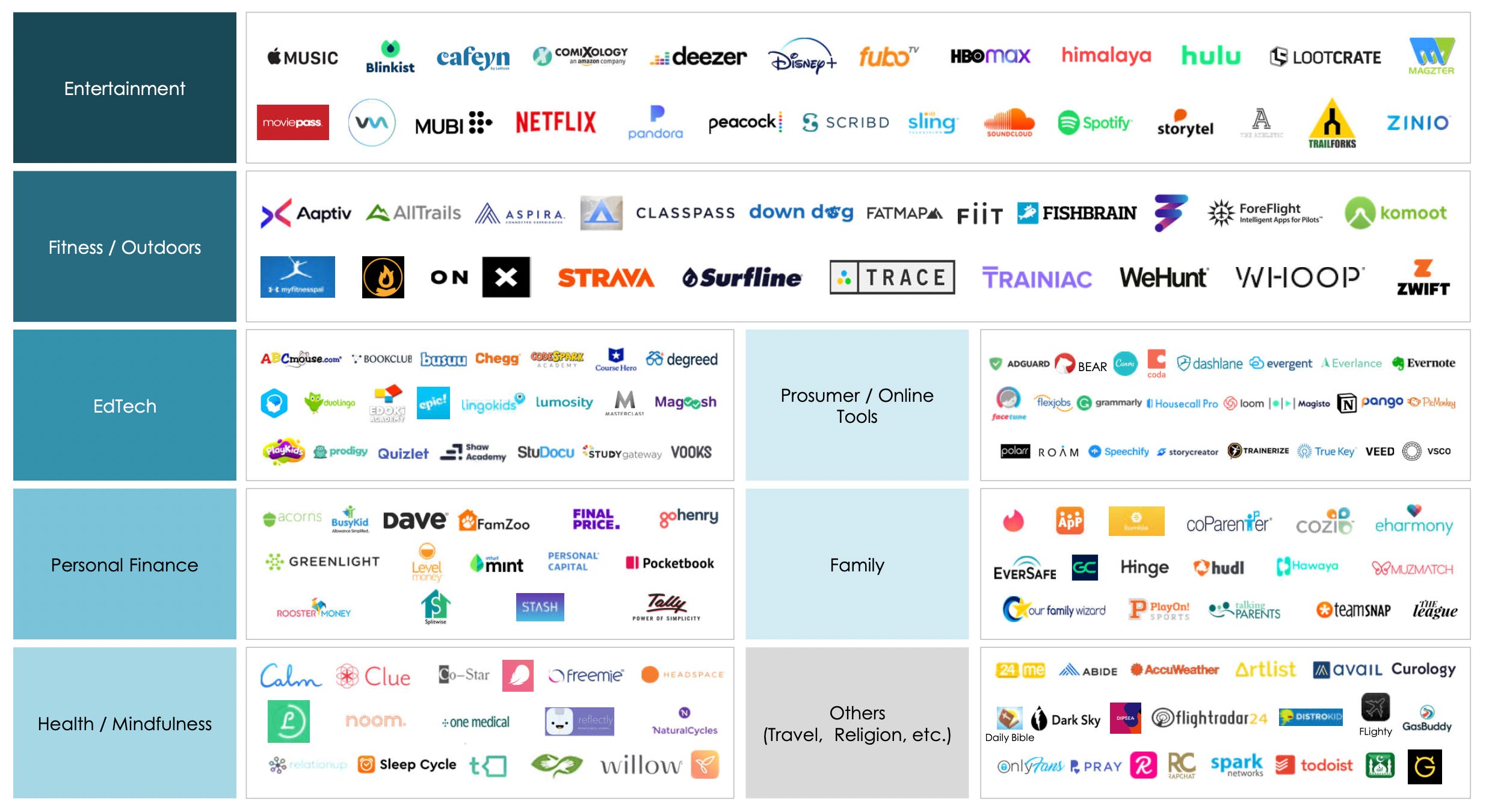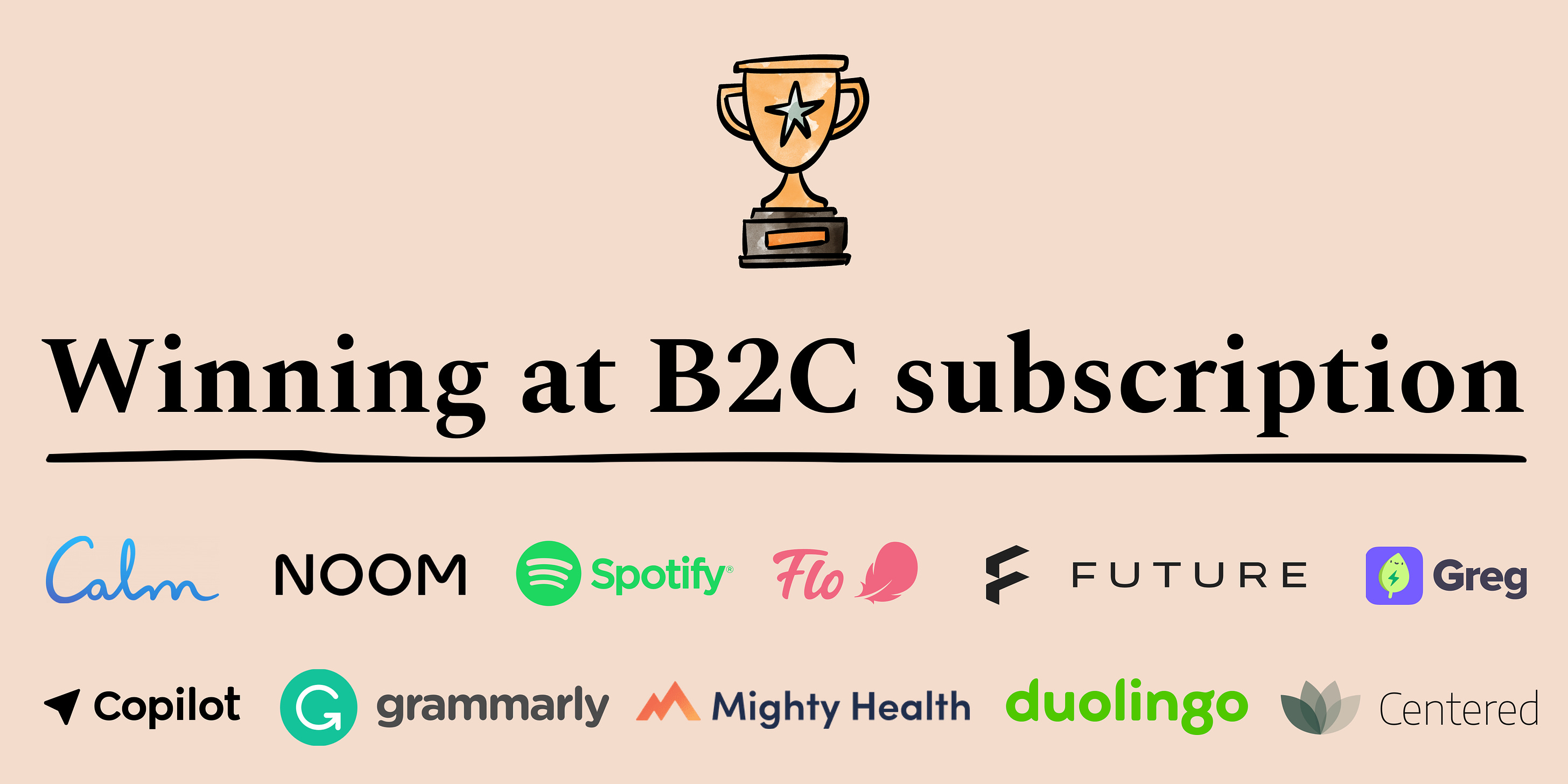Lenny's Newsletter - How to win in consumer subscription
This is a peek at today’s subscriber-only post. Subscribe to get access to this full issue—and every issue. How to win in consumer subscriptionLearnings from Noom, Duolingo, Grammarly, Calm, Spotify, Future, Flo, and others👋 Hey, I’m Lenny and welcome to a 🔒 subscriber-only edition 🔒 of my weekly newsletter. Each week I tackle reader questions about product, growth, working with humans, and anything else that’s stressing you out about work. Send me your questions and in return I’ll humbly offer actionable real-talk advice. Now, on to this week’s post…
Think about it: When was the last time you (1) installed, (2) paid for, and (3) continued to pay for, a new app? I bet you it’s been a while. For me, it was upgrading to Twitter Blue, and I’m probably going to cancel it. I certainly pay for apps (e.g. AllTrails, Centered, Copilot, Future, and a few streaming services), but I’ve tried and discarded 10x more over the years. Consumers (e.g. you and me) are busy, distractible, always looking for something new. A couple of years ago, GP Bullhound created this map of B2C subscription apps. How many are still thriving? A very small percentage.
It’s brutal out there. But it’s not hopeless. There are a number of consumer apps that have stood the test of time, including some of my favorites: Grammarly, Duolingo, Noom, Calm, Flo, Future, and Spotify. To answer your question, I went deep into these seven companies (along with a few up-and-comers like Copilot, Centered, Mighty Health, and Greg) to understand what it takes to win in the B2C subscription space. Here’s what stood out:
Below I’ll share stories and insights from each of these companies, but remember, a lot goes into building a successful company. Following all of this advice won’t guarantee you make it. In the end you still need to build something people want, continue to want, and make money doing it. But these tips will certainly help your odds. Thank you, Alex Ross (Greg), Andres Ugarte (Copilot), Artem Petakov (Noom), Cem Kansu (Duolingo), James Li (Mighty Health), Nick Lisher (Flo), Nikhil Jhunjhnuwala (Noom), Rishi Mandal (Future), Ulf Schwekendiek (Centered), and Yuriy Timen (Grammarly), for sharing their insights and advice with me for this post 🙏 Pattern #1: Obsession with efficiencyThe most common thread across every company was an obsession with efficiency—staying small, keeping costs down, and getting profitable. They all stayed lean until they found strong product-market fit and, in many cases, far beyond that. In the case of Calm, an early employee shared that “for years, they had a hard time getting funding, so they were left with no alternative but to make the business profitable. They were obsessed with profitability, margins, and LTV/CAC. They kept the team size under 10, worked long hours in a one-bedroom apartment in San Francisco, and sharply questioned every outgoing dollar.” At Grammarly, Yuriy Timen (ex-Head of Growth) shared a similar story:
Same with Noom, as Artem Petakov (co-founder) shared:
Nikhil Jhunjhnuwala (VP of Growth at Noom) went deeper:
And at Future, as Rishi Mandal (CEO) shared:
It’s probably not a coincidence that the founders of all five of the biggest B2C subscription companies are immigrants: Noom and Grammarly’s founders were from Ukraine, Duolingo’s founder is from Guatemala, Calm’s from the U.K., and Spotify’s from Sweden. Takeaway: Stay as lean as possible, and focus on revenue over growth—at least until you’ve found PMF. Pattern #2: Alignment between product strategy and acquisition strategyThe second most consistent pattern across these companies was an inseparable alignment between the product roadmap and the growth engine. Surviving in B2C is all about finding an efficient (aka cheap) growth channel. All of these five teams found a way to grow very efficiently—either through word of mouth or highly optimized paid ads... Subscribe to Lenny's Newsletter to read the rest.Become a paying subscriber of Lenny's Newsletter to get access to this post and other subscriber-only content. A subscription gets you:
|
Older messages
How to validate your startup idea
Tuesday, May 10, 2022
Lessons learned from Flexport, Vanta, Rec Room, LaunchDarkly, Pinwheel, Snackpass, Good Dog, and Cocoon—a guest post by Todd Jackson
What is a good growth rate
Tuesday, April 26, 2022
Benchmarks and insights from the world's best investors
How to interview product managers
Tuesday, March 22, 2022
Structuring the interview, skills to test, questions to ask, project examples, and more
How to develop product sense
Tuesday, March 15, 2022
Your question implies that it can be developed, and to that point, I 1000% agree. Contrary to what a lot of PMs believe, product sense is not something you need to be born with. It's a learned
A product manager’s guide to web3
Tuesday, February 15, 2022
How PMing in web3 is different, the pros and cons of going web3, how to break in, and how to be successful—by guest author Jason Shah, head of product at Alchemy
You Might Also Like
🚀 Ready to scale? Apply now for the TinySeed SaaS Accelerator
Friday, February 14, 2025
What could $120K+ in funding do for your business?
📂 How to find a technical cofounder
Friday, February 14, 2025
If you're a marketer looking to become a founder, this newsletter is for you. Starting a startup alone is hard. Very hard. Even as someone who learned to code, I still believe that the
AI Impact Curves
Friday, February 14, 2025
Tomasz Tunguz Venture Capitalist If you were forwarded this newsletter, and you'd like to receive it in the future, subscribe here. AI Impact Curves What is the impact of AI across different
15 Silicon Valley Startups Raised $302 Million - Week of February 10, 2025
Friday, February 14, 2025
💕 AI's Power Couple 💰 How Stablecoins Could Drive the Dollar 🚚 USPS Halts China Inbound Packages for 12 Hours 💲 No One Knows How to Price AI Tools 💰 Blackrock & G42 on Financing AI
The Rewrite and Hybrid Favoritism 🤫
Friday, February 14, 2025
Dogs, Yay. Humans, Nay͏ ͏ ͏ ͏ ͏ ͏ ͏ ͏ ͏ ͏ ͏ ͏ ͏ ͏ ͏ ͏ ͏ ͏ ͏ ͏ ͏ ͏ ͏ ͏ ͏ ͏ ͏ ͏ ͏ ͏ ͏ ͏ ͏ ͏ ͏ ͏ ͏ ͏ ͏ ͏ ͏ ͏ ͏ ͏ ͏ ͏ ͏ ͏ ͏ ͏ ͏ ͏ ͏ ͏ ͏ ͏ ͏ ͏ ͏ ͏
🦄 AI product creation marketplace
Friday, February 14, 2025
Arcade is an AI-powered platform and marketplace that lets you design and create custom products, like jewelry.
Crazy week
Friday, February 14, 2025
Crazy week. ͏ ͏ ͏ ͏ ͏ ͏ ͏ ͏ ͏ ͏ ͏ ͏ ͏ ͏ ͏ ͏ ͏ ͏ ͏ ͏ ͏ ͏ ͏ ͏ ͏ ͏ ͏ ͏ ͏ ͏ ͏ ͏ ͏ ͏ ͏ ͏ ͏ ͏ ͏ ͏ ͏ ͏ ͏ ͏ ͏ ͏ ͏ ͏ ͏ ͏ ͏ ͏ ͏ ͏ ͏ ͏ ͏ ͏ ͏ ͏ ͏ ͏ ͏ ͏ ͏ ͏ ͏ ͏ ͏ ͏ ͏ ͏ ͏ ͏ ͏ ͏ ͏ ͏ ͏ ͏ ͏ ͏ ͏ ͏ ͏ ͏ ͏ ͏ ͏ ͏ ͏ ͏ ͏ ͏ ͏
join me: 6 trends shaping the AI landscape in 2025
Friday, February 14, 2025
this is tomorrow Hi there, Isabelle here, Senior Editor & Analyst at CB Insights. Tomorrow, I'll be breaking down the biggest shifts in AI – from the M&A surge to the deals fueling the
Six Startups to Watch
Friday, February 14, 2025
AI wrappers, DNA sequencing, fintech super-apps, and more. ͏ ͏ ͏ ͏ ͏ ͏ ͏ ͏ ͏ ͏ ͏ ͏ ͏ ͏ ͏ ͏ ͏ ͏ ͏ ͏ ͏ ͏ ͏ ͏ ͏ ͏ ͏ ͏ ͏ ͏ ͏ ͏ ͏ ͏ ͏ ͏ ͏ ͏ ͏ ͏ ͏ ͏ ͏ ͏ ͏ ͏ ͏ ͏ ͏ ͏ ͏ ͏ ͏ ͏ ͏ ͏ ͏ ͏ ͏ ͏ ͏ ͏ ͏ ͏ ͏ ͏ ͏ ͏ ͏ ͏ ͏
How Will AI-Native Games Work? Well, Now We Know.
Friday, February 14, 2025
A Deep Dive Into Simcluster ͏ ͏ ͏ ͏ ͏ ͏ ͏ ͏ ͏ ͏ ͏ ͏ ͏ ͏ ͏ ͏ ͏ ͏ ͏ ͏ ͏ ͏ ͏ ͏ ͏ ͏ ͏ ͏ ͏ ͏ ͏ ͏ ͏ ͏ ͏ ͏ ͏ ͏ ͏ ͏ ͏ ͏ ͏ ͏ ͏ ͏ ͏ ͏ ͏ ͏ ͏ ͏ ͏ ͏ ͏ ͏ ͏ ͏ ͏ ͏ ͏ ͏ ͏ ͏ ͏ ͏ ͏ ͏ ͏ ͏ ͏ ͏ ͏ ͏ ͏ ͏ ͏ ͏ ͏ ͏ ͏ ͏ ͏ ͏ ͏ ͏ ͏


